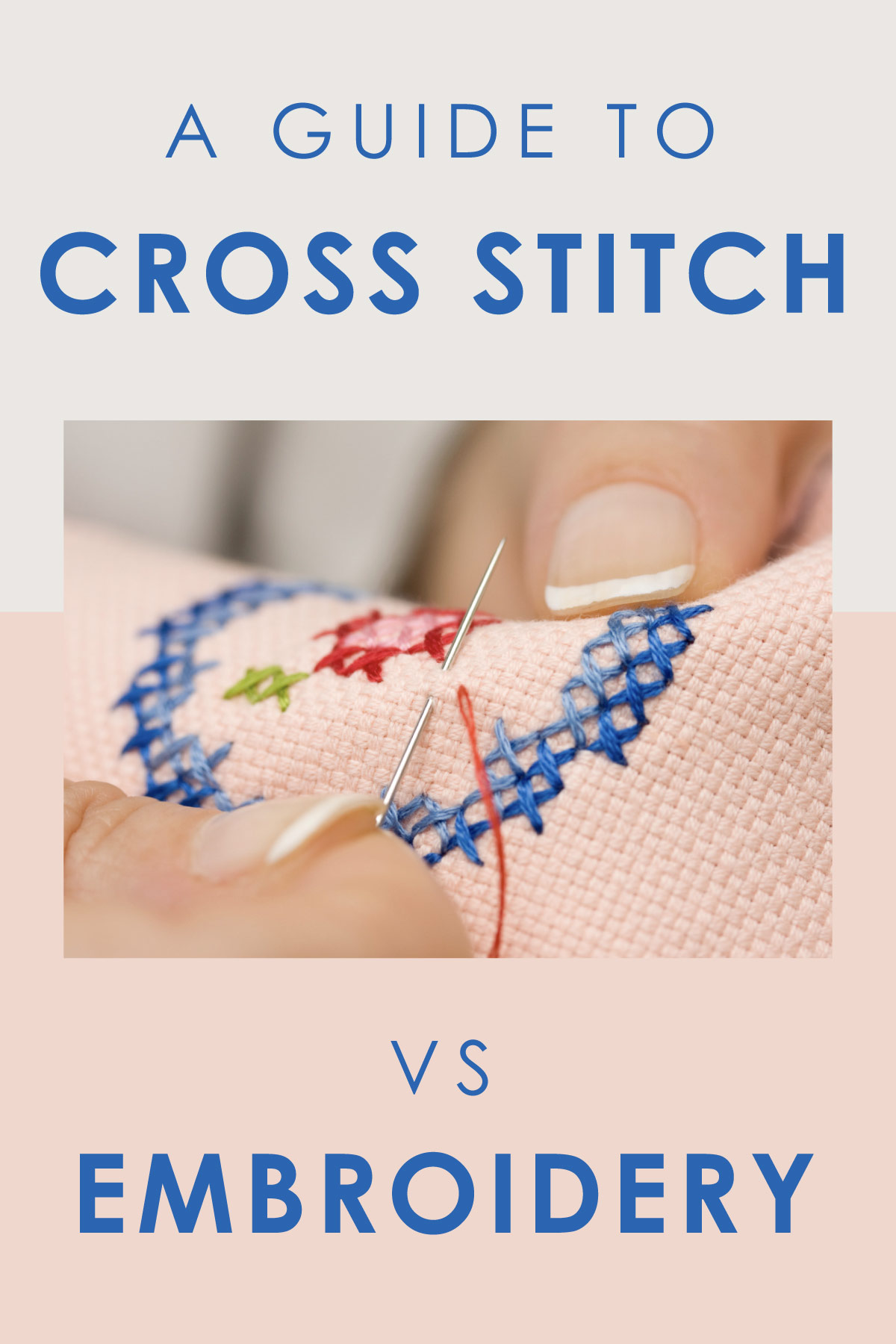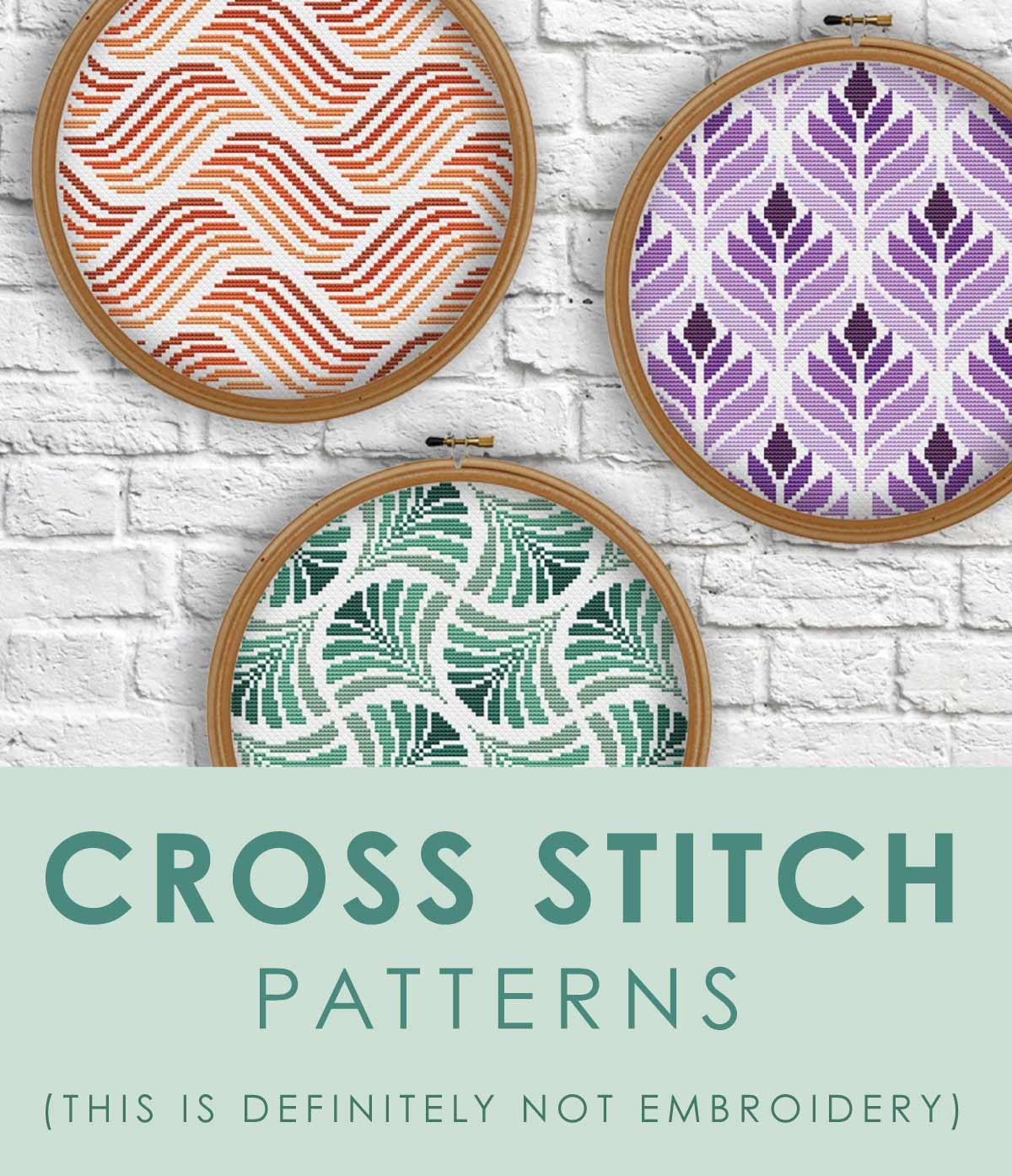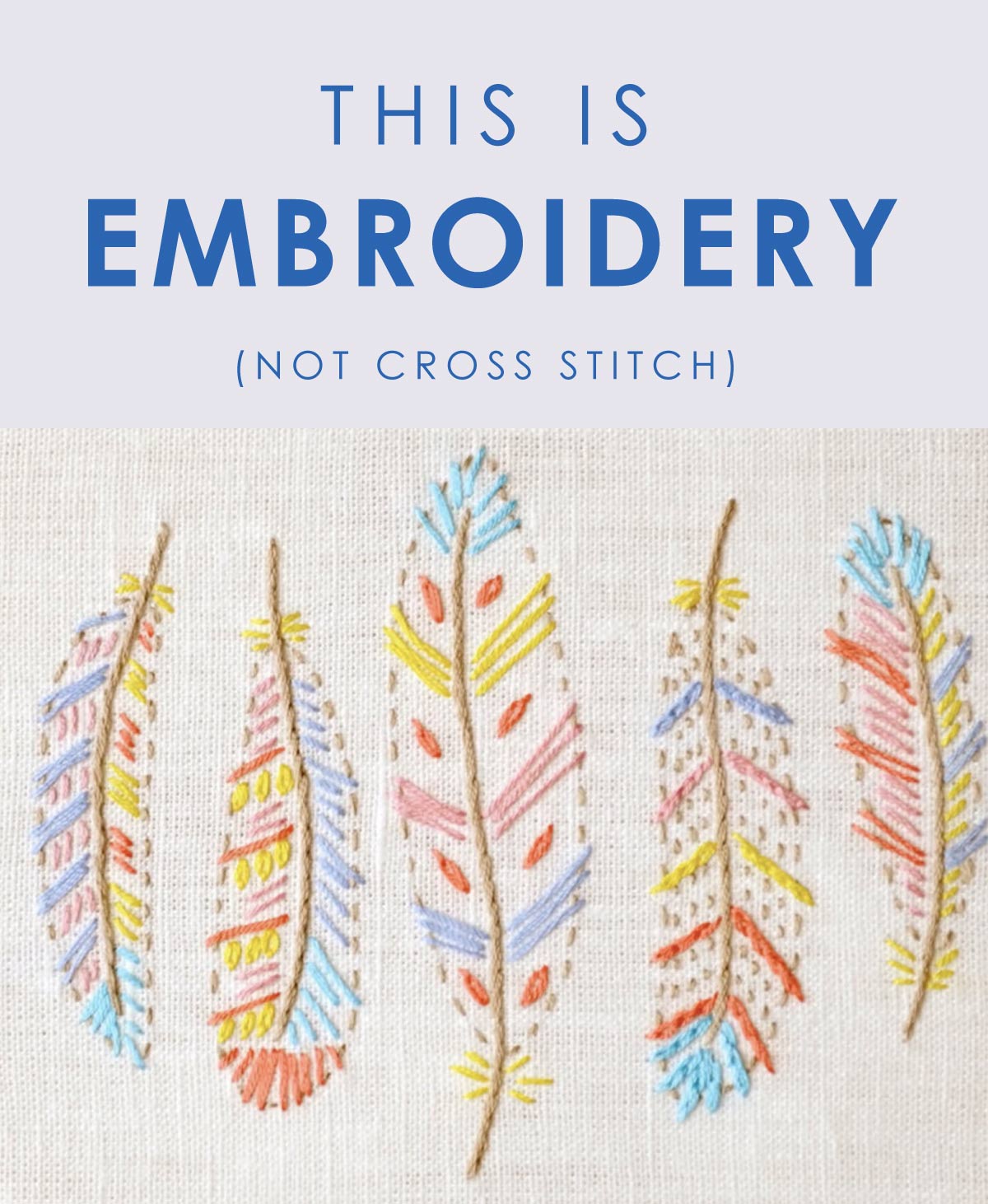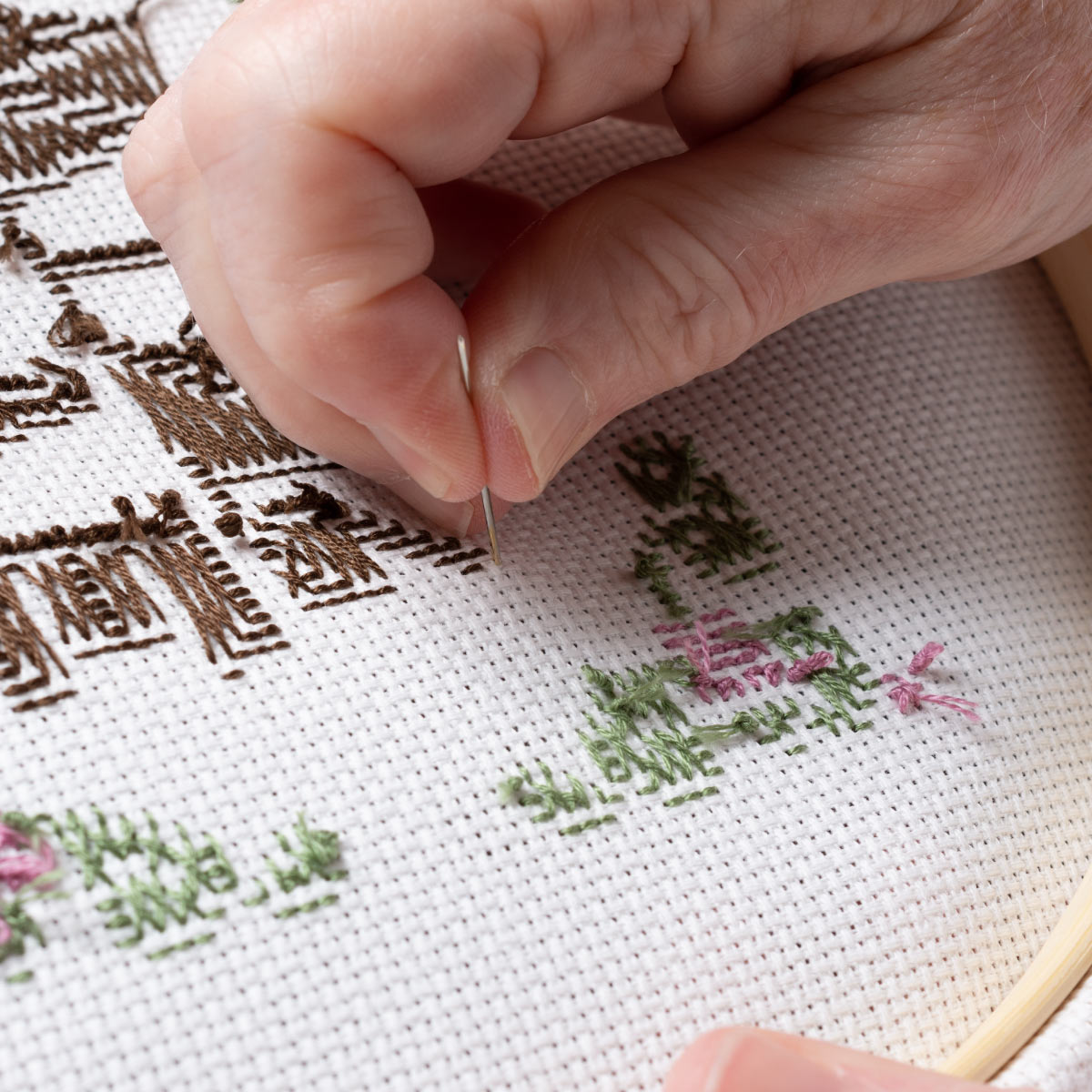If you’re new to needlework, there are so many different types of needle crafts that it can get kind of confusing as to what things are.
For example, chances are you have come across these two terms: cross stitch and embroidery.
Unfortunately, both cross stitch and embroidery refer to the same thing – sewing patterns onto fabric with thread!
This guide will help us differentiate between these seemingly similar crafts. Simply, cross stitch is a method of counted hand embroidery characterized by its use of mostly X-stitching and tile-like patterns. The art of embroidery, however, is a broader term that refers to the decorative designs that are created using needles and thread on fabrics. It is one of the oldest and most popular forms of needlework.
The Basics of Cross Stitch vs Embroidery
Technique
Cross stitch patterns use a counted-thread embroidery technique. This means that you are following a chart or pattern with specific colors and symbols that correspond to stitches. The beauty of cross stitch is that it can be used to create very intricate designs because you are only limited by the number of X’s in the pattern. Embroidery, on the other hand, does not have a set pattern and relies on your creativity to come up with something original. You can use any type of thread and any stitch you like, which gives you a lot more flexibility when it comes to design.
Fabric
Cross-stitch is often worked on Aida cloth or linen. The fabric has a thread count of 14 stitches per inch, which makes the finished product noticeably blocky. Aida cloth is great for beginners because each stitch is clearly defined and the fabric doesn’t require any hemming.
Embroidery floss is made up of six strands that are typically plied together. This type of thread is thicker than cross-stitch thread and allows more detail in your designs. Embroidery patterns also use a variety of other stitches like satin, chain, and feather. Because the fabric isn’t as tightly woven, it’s important to use an embroidery hoop to keep the fabric taut.
Outcome
The end result of cross stitching is typically neater than embroidering freehand. Stitching is done onto evenweave fabric (even number of threads per inch), with the edges hemmed. This makes it easier to create perfect stitches and avoid unwanted fraying or puckering. On the contrary, embroidery can be messy because you are working on any type of fabric; this gives you more flexibility with your designs but may also affect how they look in the end.
Not only is cross stitching more time consuming than embroidery, it also produces a higher quality finished product that will last longer. Cross-stitched items need to be washed by hand to preserve the work; otherwise, the floss will continue to unravel over time.
Embroidered pieces are best attached as decorations or embellishments instead of actual clothing items. If you plan on washing your piece, most likely it will come out of the wash with frayed edges.
Popularity
While embroidery is becoming more popular than ever, cross stitch continues to be one of the most widely practiced forms of embroidery both for hobbyists and professionals. This craft is perfect for those who like instant gratification, because it only takes a few hours (not days!) to complete a project.
5 Cross Stitch Patterns
If you’re new to cross stitching, try doing the following patterns and let us know what you think!
- I Love You Cross Stitch Pattern – This pattern is perfect for Valentine’s Day, whether it’s for your loved ones or even on a pillow!
- Spring Tree Design – Here’s another great pattern that is perfect to give as a gift on special occasions like Easter or Mother’s Day.
- Geometric Design – This is a great beginner’s project that only uses only one color in different shades and can be completed in a day or two.
- Alphabet Pattern – This one is perfect for kids who are just starting out with cross stitching! It helps them learn the alphabet while also practicing their stitching skills.
- Christmas Ornament – This one is a classic that can be used as a decoration for the holidays or even gifted as a present! The set looks beautiful on a Christmas tree or can be framed and set out as table decor.
5 Embroidery Patterns
We’ve also listed five interesting embroidery patterns you can start with to master your needlework.
- Floral Design – This is a simple but elegant design that can be used on a variety of different items.
- Monogram – This one is perfect for personalizing just about anything! Keep it in mind when giving gifts too. Most people love personalized gifts.
- Sailing Boat Applique – This is great for adding extra embellishments to clothing, home decor, and more.
- Beginner-Friendly Feathers – This is a fun and colorful design that offers a bit more detail, but is also great for kids!
- Autumn Leaves – This simple but elegant pattern is perfect for adding an autumnal touch to your home decor!
Cross Stitch Vs. Embroidery — Which Is Easier?
When you are a beginner, starting with cross-stitch makes the most sense because it is a form of hand embroidery. While all crafting requires learning and practice, cross stitching is definitely easier than embroidery because of 3 main reasons:
- Cross stitching is great for beginners because it’s easy to learn and only requires the basic x-shaped stitch.
- In cross stitching, you can easily create your own work of art by referring to an easy-to-follow tiled pattern as opposed to embroidery patterns.
- Woven fabrics for cross stitching, like Aida, feature pre-made holes that guide you where the coloured thread should go.
If you’re new to stitching, we recommend starting with cross stitch because it’s a little easier to learn and master than embroidery. Once you’ve got a handle on cross stitching, you can move onto freehand embroidery and start experimenting with adding more flair to your work.
Whether you are new to stitching or experienced in both practices, knowing the difference between cross stitch and embroidery will help you make informed decisions when choosing your next project. It is clear that both techniques are very different, not only in the way they look but also in their intended use and time commitment. If you want an easy, fast project that doesn’t require much thinking involved, then cross stitching may be the craft for you. But if you enjoy lots of creative choice and flexibility, embroidery might just be the perfect activity!
More Pattern Ideas You’ll Love
- 30 Festive Christmas Embroidery Designs – It’s that time of year when the Christmas decorations start coming out! Add something unique to your holiday decor this year with these festive Christmas embroidery designs, your perfect wintertime project. Great for beginners and people with experience!
- 25 Small Embroidery Designs and Patterns – Small hand embroidery designs and patterns can be used for all kinds of hand-embroidered projects like handkerchiefs, pillows, baby clothes, small decorative objects, and so much more. We compiled small embroidery designs and patterns to get you started!
- 27 Sunflower Embroidery Patterns – A sunflower embroidery pattern is one of the most popular patterns in needlework. Floral embroidery patterns are always beautiful to look at, and can even be easy to do. Read further for a list of beautiful sunflower embroidery patterns.



